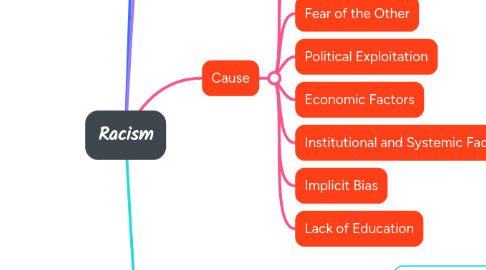
1. Definition
1.1. The belief in the inherent superiority or inferiority of certain racial groups, leading to discrimination, prejudice, and bias.
2. Types of racism
2.1. Institutional racism
2.1.1. The systemic and structural practices within organizations, institutions, or systems that discriminate against or disadvantage certain racial groups
2.1.1.1. May not be explicitly racist but have a disproportionately negative impact on marginalized communities
2.1.1.1.1. Examples: biased hiring practices, racially discriminatory policies, and unequal access to resources
2.2. Individual racism
2.2.1. Individuals hold prejudiced beliefs or engage in discriminatory actions against people of other races
2.2.1.1. Range from overt acts of racism, such as using racial slurs or committing hate crimes, to more subtle forms like microaggressions, stereotypes, or biases based on race
2.3. Systematic racism
2.3.1. The deeply ingrained racial biases and discriminatory practices that permeate all aspects of society, including politics, economics, education, and healthcare
2.3.1.1. Creates and perpetuates racial inequalities and disparities that persist over time
2.4. Cultural racism
2.4.1. The denigration or devaluation of a particular racial or ethnic group's cultural practices, values, or traditions
2.4.1.1. Implies that one's own culture is superior and that other cultures are inferior or exotic
2.4.1.1.1. Can lead to cultural appropriation, stereotypes, and the erasure of minority cultures.
2.5. Colorism
2.5.1. A form of discrimination based on skin color within a racial or ethnic group
2.5.1.1. The preference for lighter skin tones over darker ones
2.5.1.1.1. Can lead to disparities in opportunities and treatment, as well as negative stereotypes associated with darker skin tones
3. Cause
3.1. Historical Legacy
3.2. Socialization and Cultural Factor
3.3. Fear of the Other
3.4. Political Exploitation
3.5. Economic Factors
3.6. Institutional and Systemic Factors
3.7. Implicit Bias
3.8. Lack of Education
4. Effects
4.1. Anger
4.1.1. Experiences of racism can lead to feelings of anger, resentment, and frustration among those who are targeted.
4.2. Guilt and Shame
4.2.1. Witnessing or being complicit in racism can lead to feelings of guilt and shame among individuals who recognize the injustice but do not take action.
4.3. Income Disparities
4.3.1. Racism can result in income disparities, with racial minorities often earning less than their white counterparts for similar work.
4.4. Wealth inequality
4.4.1. Historical disadvantages due to racism have contributed to wealth inequality, with racial minorities having less access to generational wealth and financial resources.
4.5. Low Self Esteem
4.5.1. Experiencing racism can lead to feelings of self-doubt, self-hatred, and low self-esteem among individuals who are targeted.
4.6. Stress and Anxiety
4.6.1. The constant threat of racism and discrimination can lead to chronic stress and anxiety, which can have detrimental effects on mental health.
4.7. Depression
4.7.1. Racism can contribute to the development of depression, particularly when individuals face discrimination and marginalization over an extended period.
4.8. Mental illness
4.8.1. Post-Traumatic Stress Disorder (PTSD)
